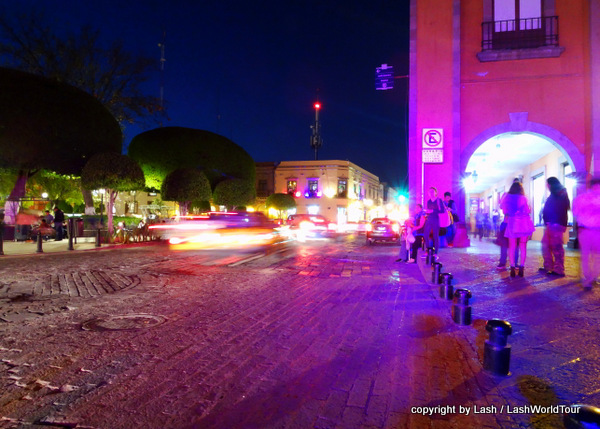 All About Gueretaro – Mexico
All About Gueretaro – Mexico
Gueretaro is a large historic city located about three hours northwest of Mexico City. Although its metropolitan area is a sprawling, modern industrial mess, the compact central historic district offers many wonderful attractions, including several intriguing features unique to Gueretaro.
With blocks and blocks of stone-paved roads lined by gorgeous period architecture, impressive churches, several excellent museums, attractive plazas, lush parks, dozens of quaint upscale restaurants, cafes and bars, and a very important role in Mexico’s independence, Gueretaro can easily keep visitors busy for up to one full week.
While Gueretaro is in many ways very similar to most other historic Mexican cities, several uniquely Gueretaro attractions make the city call for exploration. Here’s what I discovered only in Gueretaro during my one-week visit:
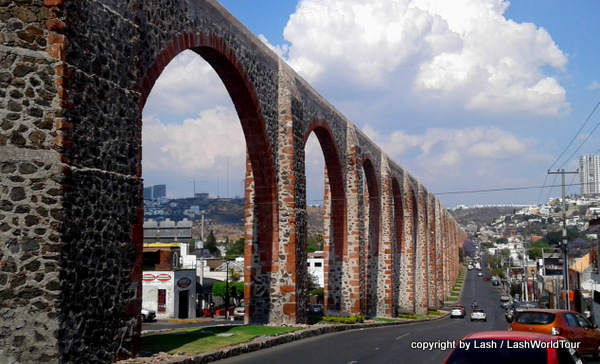 Unique Attractions in Gueretaro
Unique Attractions in Gueretaro
Historic Aqueduct
This astoundingly high and long stone aqueduct is a stunner. Its 74 sandstone arches start near the top of a small hill on the edge of Gueretaro’s historic district and soars off into the far distance, exactly 1.28 km, leaving you wondering how the heck it was constructed way back in the early 1700s.
The entire stone structure is beautifully restored, with practically sparkling stone work.
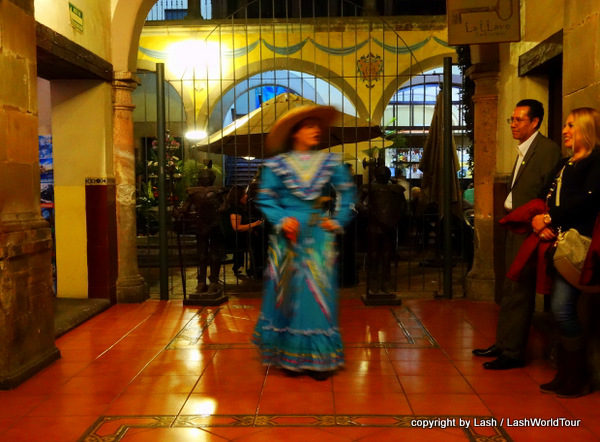
dramatic historical re-enactment on city walking tour
Theatrical Night-time City Walking Tours
Gueretaro’s past is filled with famous true tales of intrigue that include familial murders, incestuous relationships and Mexico’s underground independence movement.
To relate these sordid scandals, several local tour groups lead night-time city walking tours with guides dressed in period costumes and costumed-actors giving dynamic re-enactments of the stories.
The tour I joined was a spooky/comic re-enactment. Our elderly guide, looking much like Igor, marched us through the city carrying a long, well-lit wooden torch and had us shouting ‘Muerte!’ (death!) and ‘Viva Mexico’ (Long live Mexico) as people gawked as us in surprise.
Various tour staff jumped out as us in dark alleyways and made creepy, alarming noises to scare us. The re-enactments invariably induced group members to play parts, mostly for the purpose of ‘getting murdered’ and having to lay on the ground as victims. One woman was pulled in to waltz. Other actors threatened us with knives and guns.
It was one of the most amusing, entertaining events I’ve joined in a long, long time.
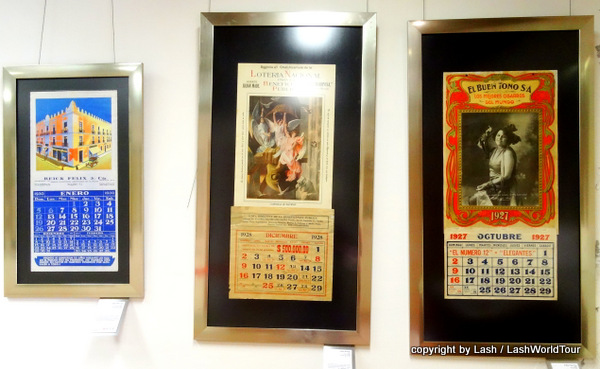
historic Mexican calendars
Museum of World Calendars (MUCOL)
This enthralling museum is situated in a gorgeously renovated historic town house, complete with several garden courtyards, a large rooftop terrace with views, long open-air stone hallways and rooms upon rooms detailing everything you could possibly learn about calendars.
The exhibitions start with a detailed introduction to calendar systems from around the world: Mayan, Inca, Chinese, Hebrew, Hindu, Persian, Celtic, Roman, Egyptian, French and others. It also explains the origins of words for days, months and other time-related terms.
There are rooms devoted to the print and lithograph processes used to make modern-day print calendars, the solar system, and other things related to calendar creation.
The museum has a very extensive collection of Mexican calendar samples dating from the 1920s all the way up to the present year. The period calendars are really interesting and teach you a lot about Mexican history and daily live in different decades.
Several other rooms are devoted to the large, colorful dramatic calendar paintings of Mexico’s most famous calendar artists from the 1930s-60s.
A lovely cafe is situated in a lush garden. Then there’s the house itself and its gorgeous courtyards, hallways, gardens and architecture to admire.
It’s really an excellently presented museum, I must say.
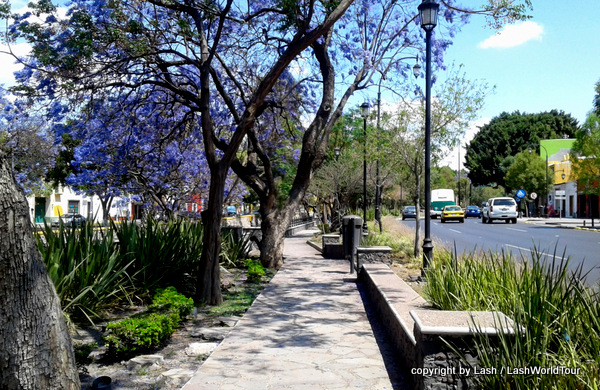 Garden-lined Gueretaro River
Garden-lined Gueretaro River
Stately University Avenue runs along both sides of narrow Gueretaro River (a stream really) roughly from east to west, marking the northern edge of Gueretaro’s historic center.
For more than 2.5 km the stream is lined by lovely stone-paved sidewalks, dipping and curving under beautiful flowering trees, bushes and clumps of irises.
Stone benches are plentiful, so its easy to stop for a rest under the shady trees.
The garden-lined river is a unique and charming feature of Gueretaro city that I haven’t seen in any other Mexican cities thus far.
The walk does suffer one unfortunate drawback, though. The stream is so badly polluted that it’s an opaque dark khaki color, often full of suds, as if for a bubble-bath, and it stinks terribly.
If you can tolerate the odor or manage to walk downwind (seriously, this works) or a perfectly windless day you’ll find the garden walk really lovely.
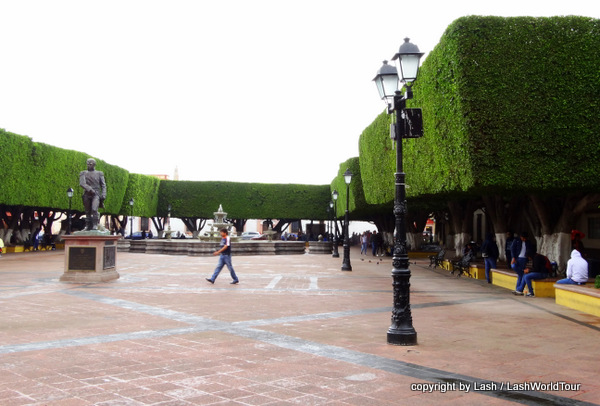 Sculpted Shade Trees
Sculpted Shade Trees
The uniquely sculpted, dense shade trees accenting nearly every plaza in Gueretaro – and some streets, too – are quite remarkable. I’ve never seen them anywhere else in all my world travels. Nor in any of the dozens upon dozens of parks and plazas I’ve visited all over Mexico.
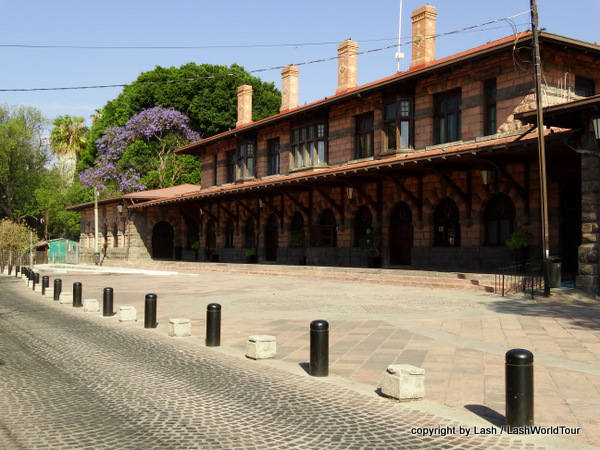 Historic Train Station
Historic Train Station
Very few Mexican towns or cities even have a train station, let alone a functioning one. That makes Gueretaro’s handsome stone train station unique.
Built in 1902, the building has been beautifully renovated, inside and out, making it essentially a museum, though it’s not designated as such. Visitors are welcome to visit for free during opening hours. From the broad wooden platform they can watch passing cargo trains roar through.
Although the trains don’t stop in Gueretaro, they do blow their horns proudly as they chug through the city several times a day, until about 10 or 11 pm.
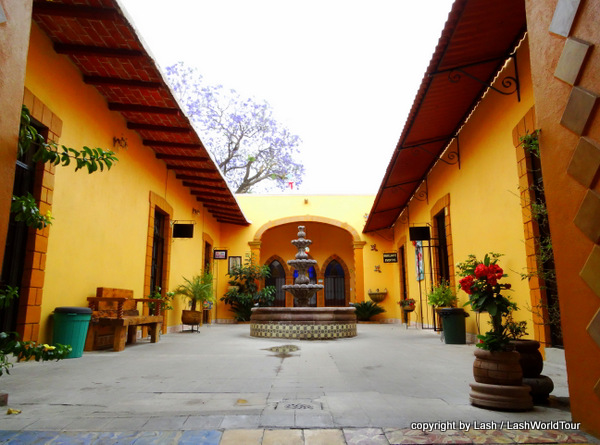
open courtyard in a random Gueretaro building
Gueretaro Sights Common to other Mexican cities
Most of Mexico’s historic towns and cities were built by the Spanish in the 1500s and 1600s. As a result, they share most of the same features. They’re centered around a main plaza, which is usually an open stone-paved square with some shady trees and public benches.
Typically, a cathedral lines one side of the plaza and imposing government buildings, with columned stone-arched open hallways, run along the other sides.
Many towns still have stone-paved streets, though not all. Either way, roads are lined by un-separated buildings, of roughly the same type of architecture (from the 1500s-1600s). They now house various stores, restaurants, cafes, ice cream parlors, bars, hotels and other modern-day shops.
All of Mexico’s cities seem to have several excellent museums housed in beautifully-restored historic buildings, showcasing great art exhibitions or other themed exhibits.
Gueretaro is no exception. However, that certainly doesn’t detract from its beauty. It’s well worth wandering Gueretaro’s beautiful streets, admiring the architecture and perhaps darting into some inviting open entryways to discover gorgeous interior courtyards and open-air hallways.
I’m merely pointing out that the city’s pretty plazas, stone-paved streets, pedestrian roads, renovated buildings and lovely churches are features you’ll also see in most other Mexican towns and cities. Although each town does somehow manage to have its own special atmosphere.
So go to Gueretaro to admire more historic Spanish-designed towns or go for the city’s unique attractions. Either way, it’s a city well-worth visting in central Mexico.
You might also enjoy:
10-100 Free Things to do in Mexico City
=========================================








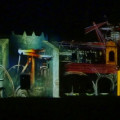
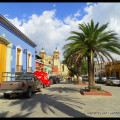

 Hi! I'm Lash, an American nomadic world traveler who's been traveling solo since 1998. I’m passionate about traveling the world nomadically and then sharing it all with you. I hope to inspire you to travel the world, to entertain you with tales from the road, and to help you reach your travel dreams. Welcome!
Hi! I'm Lash, an American nomadic world traveler who's been traveling solo since 1998. I’m passionate about traveling the world nomadically and then sharing it all with you. I hope to inspire you to travel the world, to entertain you with tales from the road, and to help you reach your travel dreams. Welcome! 



